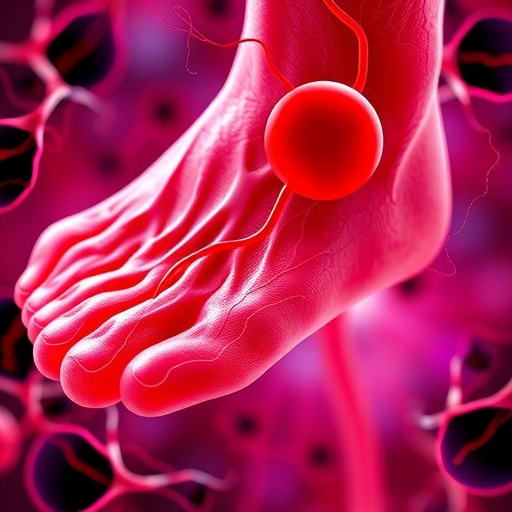In recent years, the management of diabetic neuropathy has gained significant attention in the medical community, particularly in the UK where primary care settings serve as a frontline for treatment. The study led by Fernando, Bell, and Davies examines how a pragmatic approach can enhance both management strategies and patient flow for those suffering from this painful diabetic complication. The findings are crucial as they address the challenges faced by healthcare providers in delivering effective treatment while ensuring that patient needs are prioritized.
Diabetic neuropathy is a debilitating condition that affects many individuals with diabetes, leading to considerable pain and discomfort. The nature of the condition often results in a complex interplay between clinical management and patient experience. As patients navigate their treatment pathways, there’s an urgent need to streamline healthcare processes to accommodate better patient flow, which this study aims to elucidate.
Central to the study’s findings is the call for integrated care pathways that not only focus on medication but also include patient education and psychological support. The authors highlight the importance of cognitive understanding and emotional well-being in the overall management of painful diabetic neuropathy. This emphasis on holistic care reflects an evolving paradigm within healthcare that values the patient’s voice and experience as a critical component of effective treatment.
Furthermore, the study advocates for a multidisciplinary approach, which is essential in managing the multifaceted aspects of diabetic neuropathy. By involving professionals from various fields—such as endocrinology, pain management, and psychiatry—the research suggests that more comprehensive care can be delivered. This not only leads to better clinical outcomes but may also enhance patient satisfaction, as individuals feel more supported throughout their treatment journey.
The implementation of a standardized protocol as proposed in the study is yet another significant aspect. The authors suggest that clear guidelines should govern the management of diabetic neuropathy cases in primary care settings. Such a framework would streamline processes, reduce ambiguity, and ensure that all healthcare providers follow best practices when treating patients. This could be particularly beneficial in settings where resources are limited, helping to maximize the impact of the available healthcare staff.
An exploration of patient flow within healthcare systems unveils another critical factor that impacts treatment outcomes. The study details how bottlenecks in care can lead to increased patient frustration and diminished overall health results. By identifying these bottlenecks, healthcare providers can work towards optimizing the patient experience, making necessary adjustments to appointment scheduling, follow-ups, and resource allocation.
The paper also discusses the role of technology in enhancing patient management. With digital health tools on the rise, incorporating telemedicine and remote monitoring could fundamentally alter the landscape of diabetic neuropathy care. By facilitating real-time communication and data exchange between patients and healthcare providers, technology can empower patients to take charge of their own health, leading to better adherence to treatment plans.
Moreover, the financial implications of effective management cannot be overlooked. The authors indicate that improving management strategies could lead to considerable cost savings for the healthcare system as a whole. By reducing the incidence of complications associated with poorly managed diabetic neuropathy, healthcare providers can save on the long-term costs of treatment, which are often exacerbated by subsequent health deterioration.
A key takeaway from the study is the importance of continuous professional development for healthcare providers. As the field of diabetic neuropathy care evolves, ongoing education and training are essential to ensure that providers are equipped with the latest knowledge and techniques. This commitment to lifelong learning will ultimately resonate in improved patient care and outcomes.
In light of the findings, it’s clear that further research is warranted. While the study offers valuable insights, exploring additional factors influencing patient flow and management strategies in different healthcare settings will bolster the understanding and treatment of diabetic neuropathy. Future research can also examine long-term outcomes from implementing the proposed strategies, solidifying their place in standard practice.
In conclusion, the study by Fernando et al. underscores the pressing need for a holistic, integrated approach to managing painful diabetic neuropathy. By focusing on patient flow, standardization, technology, and professional development, healthcare systems can transform the treatment landscape for individuals suffering from this challenging condition. The implications of such changes could be profound, offering not just relief to patients but also instilling a framework for sustained improvement in diabetic care.
With the increasing rates of diabetes worldwide, addressing complications like neuropathy is more critical than ever. The proactive steps toward management outlined in this study could define the future of primary care in treating painful diabetic neuropathy, ultimately allowing patients to lead more comfortable and fulfilling lives.
Subject of Research: Management of Painful Diabetic Neuropathy in UK Primary Care
Article Title: A Pragmatic Approach to Improving Management and Patient Flow for Painful Diabetic Neuropathy in UK Primary Care
Article References:
Fernando, K., Bell, H., Davies, S. et al. A Pragmatic Approach to Improving Management and Patient Flow for Painful Diabetic Neuropathy in UK Primary Care.
Diabetes Ther (2025). https://doi.org/10.1007/s13300-025-01797-6
Image Credits: AI Generated
DOI: 10.1007/s13300-025-01797-6
Keywords: Diabetic neuropathy, pain management, primary care, patient flow, multidisciplinary approach, telemedicine, healthcare protocol.
Tags: challenges in diabetic neuropathy carediabetic neuropathy management strategiesemotional well-being in chronic illnessenhancing patient flow in healthcareholistic care in diabetes treatmentimproving patient experience in healthcareintegrated care pathways for diabetic patientspatient education for chronic pain managementpragmatic approaches to chronic painprimary care treatment approachespsychological support in diabetic neuropathyUK healthcare strategies for diabetes management





